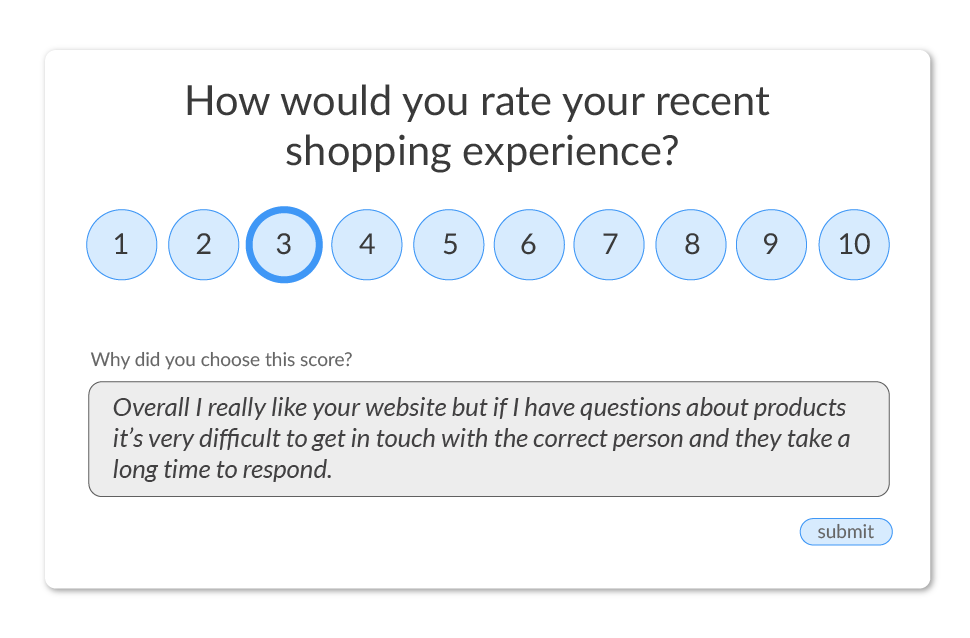NPS is a simple framework you can use to help understand your customers’ loyalty to your brand. The Net Promoter Score metric seeks to measure not just customer satisfaction after a given interaction, but specifically whether or not customers like your organisation enough to tell their friends about it.
With customer satisfaction and retention more important to organisations than ever before, it is important to not only measure and track your NPS ongoing to monitor changes in consumer behaviour and experiences, but more importantly to understand the reason behind why customers choose to score your organisation the way they do.
Tracking your NPS (including the trend of changes over time) along with in-depth analyses into the text feedback responses, provides businesses with the insights necessary to improve or eliminate the issues customers experience, leading to higher retention and a better understanding of buyer behaviour that can be applied to drive meaningful, measurable change for your customers and your ROI.
Critics believe that NPS is a dying customer experience (CX) metric, but with powerful collection and analytics tools the common issues these critics cite can be eliminated. Let’s break down how NPS works overall and how you can leverage it to gain deeper insights into your customer experience and drive measurable improvements.
How NPS surveys work
An NPS survey (usually distributed via email) allows you to quickly quantify how satisfied (or unsatisfied) a customer is and why.
Once a transaction or interaction has happened, a survey will be sent to the user asking two simple questions, for example:
- Following your experience in our shop today, how likely are you to recommend (your business) to a friend or colleague on a scale of 1-10
- What is the reason for your score?
The idea behind the simple, single-question format is to make it as easy as possible to get quantifiable feedback at a high response rate. Responses can be categorised into three groups;
- People who rated their experience from 9-10 are called promoters – individuals who have a high level of satisfaction and would recommend you. These customers are avid supporters, your company’s biggest fans.
- People who rated their experience 7-8 are the passive group – individuals that are satisfied but are not completely loyal specifically to you. They might say their experience was “fine” or “okay”.
- Those who rated their experience from 0-6 are detractors – these people are unsatisfied by the service / experience they received and will not recommend (or worse) negatively discuss their experience. We find that members of the detractor group are often very willing to discuss exactly why they are unhappy with the service they received.

The first part of a successful NPS framework is in data collection. The best, most useful responses come when the initial question is posed about a specific, quantifiable experience that the customer recently had with your organisation. The generic “How likely would you be to recommend our gadget store to your friends and family?” arriving in a customer’s inbox a few weeks after they purchased is less likely to yield benefit than a more specific question like “Based on your shopping experience at your local gadget store last Friday, how likely would you be to recommend….”
The key elements to the message are specificity and timeliness. For best results, combine your loyalty, transactional, or CRM data with a powerful automation tool to deploy customised NPS surveys to different customer segments, and measure the differences and themes in their responses to diagnose issues that may only be impacting some customer segments. Customers who shop online, for example, won’t be able to comment on the friendliness of in-store staff. If customers purchased a specific product, you may wish to include a mention of that product in the message. Dynamic messaging can help further customise messages to improve response rates, and TouchpointMX can facilitate all of these elements.
This second question is the follow-up open-field text box. This, for many organisations, is buried treasure: the answer to “why” your customers score their experience the way they do. If you’re running a small business and receiving only a few responses each week, you might read through these responses to understand whether there are any themes in the comments. When a larger business receives hundreds (or thousands) of responses each week, or runs sequential interaction-based NPS collections, this isn’t scalable. Imagine reading, recording and then acting on hundreds of survey responses each week – it’s unrealistic, impractical, and leads to businesses choosing to simply ignore this valuable source of information - but there’s another way!
Understanding the true potential of NPS and how it can dramatically change your customer experience.
We’ve established that the follow-up text field where respondents answer the question ‘What is the reason for your score?’ is a gold mine of information about your customers, their interaction with your business, their buying behaviour, and the impact that issues can have on retention, loyalty, and business performance.
Reading these responses and understanding common themes that arise will help you plan and manage your customer experience strategy. Better still, it will help you understand what steps you need to take to improve internal operational processes that will in turn lead to improved business performance, customer (and staff) retention, and an increase in profit and customer loyalty.
The benefits are abundant, but so are the answers… How do you condense this into something meaningful? You use AI Text Analytics. It’s not a new concept in the CX world, but many businesses don’t yet understand its true potential. Get ready, here’s the plug (of course! We’re a Text Analytics company after all!) but more importantly an overview so you can understand its true value.
Ipiphany, Touchpoint Group’s AI text analytics tool, reads and categorises open-text feedback with human-like understanding, which enables the user to analyse thousands of rows of unstructured text (open-text field questions) from a range of customer feedback sources in a structured and quantifiable way. This can be anything from online or email web forms (like your NPS surveys) to social media comments and product reviews on third party sites such as TrustPilot. Choosing an AI text analytics tool, removes the manual process of gathering, tagging, segmenting and categorising responses. Ipiphany runs this process automatically, and within seconds you get an overview of what issues your customers are facing when dealing with your company or product – many tools can do this for you, but Ipiphany can go much deeper, and here’s why.
Understanding the issues is part one, fairly straightforward. You most likely have a good idea of what the main issues are within your business. Finding the root cause of that issue is step two, a step which many other text analytics tools lack. The real gold lies in using the data to provide actionable solutions to these issues and understanding where to target your efforts first to improve your NPS score – this is where Ipiphany becomes the leader in its market.
Just because an issue is raised more often by more people, doesn’t mean it is always the best one to prioritise. Sometimes an issue that is extremely negative for a smaller subset of customers is more detrimental than an issue causing mild irritation for more customers. This insight is not possible to notice by manual analysis, but it is possible with Ipiphany’s unique impact measurement and prioritisation tools.
What’s Next?
Now that you’re sending timely, specific NPS surveys to all your customer segments and measuring their feedback to understand how to make improvements, all you need to do is keep it up! Analysing feedback trends over time will help you understand what impact changes in your business have (like a new product release, or an increase in contact centre staff) as well as help you measure the results of the improvements you’ve made. You can continue to send surveys to the same segments to monitor them over time, or include more segments or interaction points if you realise you need more data about a particular aspect of your customer experience.
NPS collection and analysis remains an incredibly important part of the CX toolkit as it is designed to be extremely easy, familiar, and provide you with a gold mine of information should you be willing to analyse it. It also enables you to track your business improvement progress and understand where consumer behaviour and experiences change.
If you want to learn more about how to send and capture your NPS or analyse themes, trends, or issues (even with historic data), get in touch to discuss your requirements.

